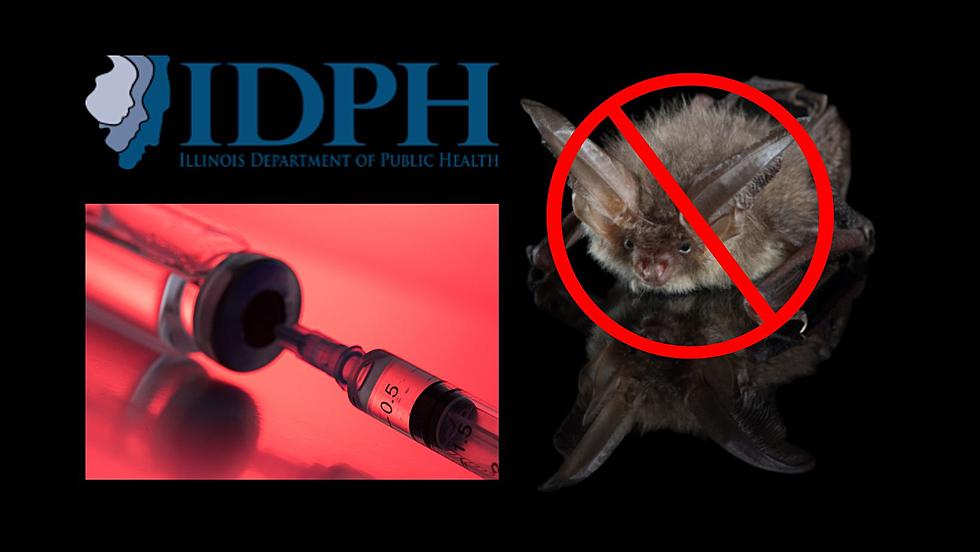
Illinois Rabies Alert- Bat Watch 2023
The Illinois Department of Public Health issued a warning about the dangers of rabid bats on Wednesday, July 26th.
So far this year a total of 27 rabid bats have been found in the state; five rabid bats each in Kankakee and Lake counties, four in Cook County, and three in McHenry County. Rabies has also been found in bats in Bureau, Clark, DeKalb, Macon, McLean, Peoria, Rock Island, Sangamon, Wayne, and Will counties.
“Rabies is a fatal but preventable disease. It is important that Illinois residents know how to prevent rabies exposure to protect themselves and their loved ones. Rabies can be prevented in a number of ways including vaccinating pets, being cautious around wildlife, and seeking medical care immediately after a potential exposure. If exposed, please seek medical attention immediately.”
-Dr. Sameer Vohra, IDPH Director
The deadly rabies virus affects the brain and nervous system and is present primarily in the saliva, brain tissue, and spinal fluid of a rabid animal. Anyone who gets bitten by a wild animal should seek medical attention – as rabies treatment needs to begin a few days after exposure.

People are exposed to the rabies virus when an infected animal bites them. Exposure also occurs if the animal's saliva enters an open cut or mucous membrane (nose, mouth, eyes). The presence of a bat in a home, or any contact with a bat, represents a possible hazard for rabies and should be reported to the local health department so that the circumstances can be evaluated. The last human rabies case in Illinois was reported in 1954.
How can I identify a rabies infected animal?
The first sign of rabies is usually a change in the animal's behavior. An animal doesn't need not be "foaming at the mouth" to have rabies. Other more typical signs include:
- Difficulty walking
- A general appearance of sickness or a change in the animal's normal behavior. For example, if an animal that is normally wild and avoids contact with humans approaches a picnic area, campsite or home and appears tame or friendly, consider it rabid.
- If a normally tame and friendly animal becomes hostile or aggressive without provocation, it too should be considered rabid.
- A rabid animal usually dies within one week after showing signs of the disease.
A bat that is active during the day, is spotted on the ground, or can't fly is more likely to be rabid. In addition, anyone who discovers a bat in their home should avoid killing OR releasing the animal. Contact your local animal control or health department to determine your next steps.
How can I protect my animals & pets from rabies?
- Keep your dogs and cats up to date on rabies vaccination per state law and to protect them against an exposure.
- Horses, sheep, cattle and ferrets can also be vaccinated for rabies.
- Call your veterinarian if your animal has been exposed to a high-risk animal, especially bats.
How Do I Keep Rabies From Spreading?
- Do not touch, feed, or unintentionally attract wild animals with open garbage cans or litter.
- Never adopt wild animals or bring them into your home. Do not try to nurse sick wild animals to health. Call animal control or an animal rescue agency for assistance.
- Teach children never to handle unfamiliar animals, wild or domestic, even if they appear friendly. “Love your own, leave other animals alone” is a good principle for children to learn to reduce the risk of exposures to rabid animals.
- Maintain homes and other buildings so bats cannot get inside.
- If a bat is in your home, do not release the bat outdoors until after speaking with animal control or public health officials.
- After consulting with animal control or public health officials, the bat may need to be captured for rabies testing to determine if you need preventive treatment or if your pet may have been exposed.
How can I capture and in home bat safely?
- When the bat lands, approach it slowly.
- While wearing thick gloves, place a box or coffee can over the bat.
- Slide a piece of cardboard under the container to trap the bat inside.
- Tape the cardboard to the container securely, and punch small holes in the cardboard, allowing the bat to breathe.
- Call animal control.
- Do not come into physical contact with the bat.
- If the bat is dead, put it in a plastic container and keep it cool while waiting for animal control to pick it up for testing.
You can find more information about rabies and how to prevent exposure at the Illinois Department of Public Health website: Rabies (illinois.gov).
WATCH OUT: These are the deadliest animals in the world
LOOK: 11 tick-borne illnesses and what to watch out for during your outdoor adventures
Hiking Trails and Nature near Dubuque, Iowa
More From Eagle 102.3









